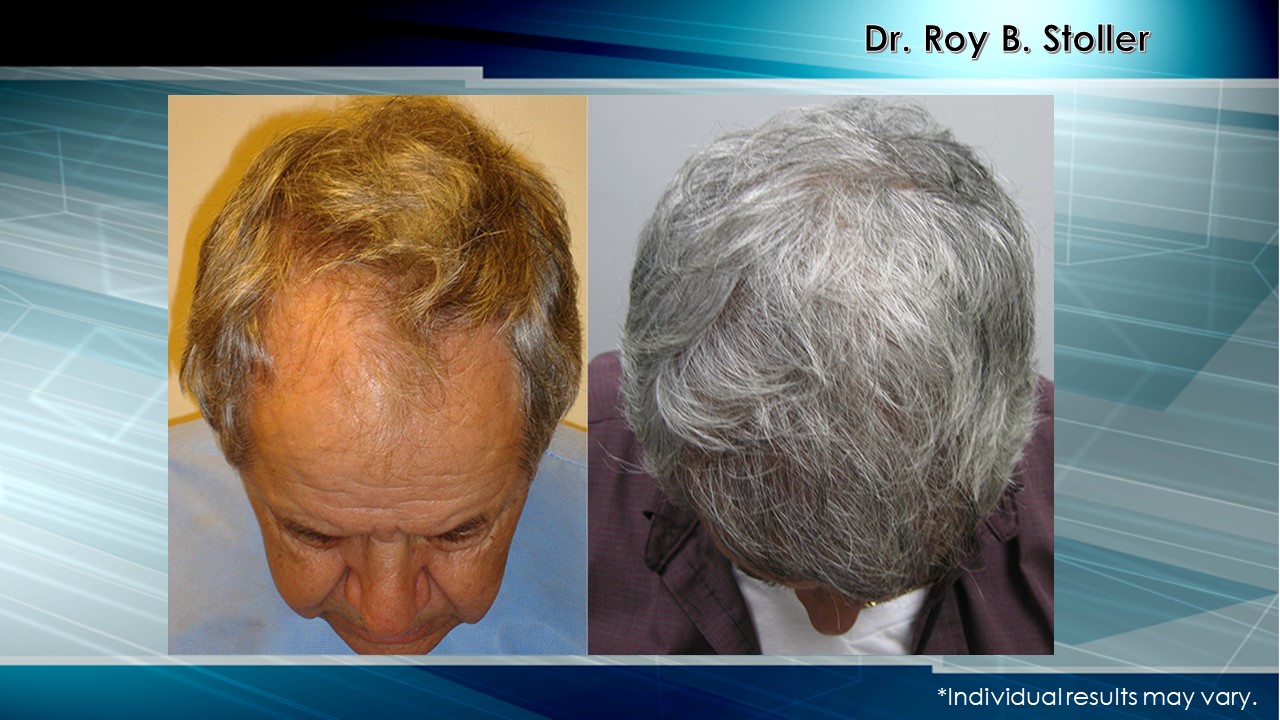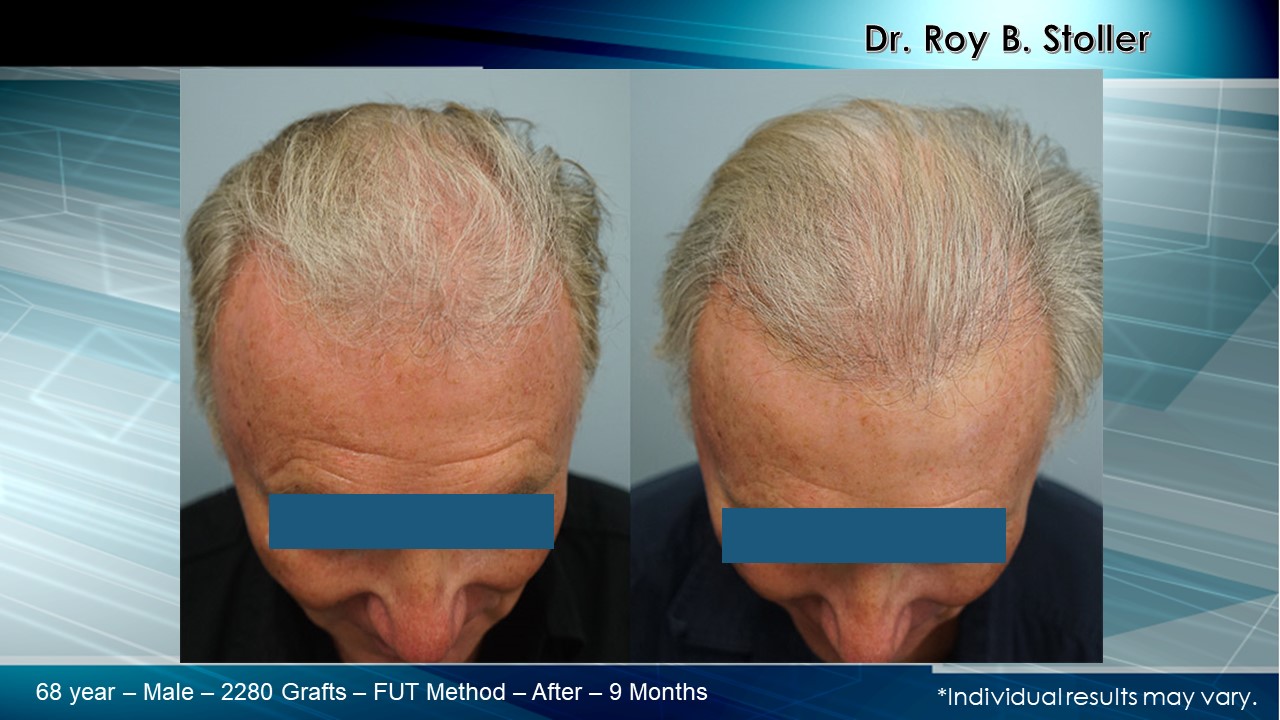Strip Harvest Technique
Hair Transplants
The FUT Process
FUT is often recommended for clients that need a larger amount of hair for a highly noticeable receding hairline, to add heavy density or coverage for excessive crown balding.



During an FUT procedure, follicular units are extracted from a strip of donor tissue secured from the back of the head – an area that is not genetically predispositioned for baldness, thereby easily concealing a minimal scar*.
After placing the graft in a holding solution and the health is determined to be the best possible graft, Dr. Stoller begins implanting; precisely pinpointing where the new hairs will be transplanted and how to create the dense hair and shape that you are seeking.
In one sitting Dr. Stoller may extract over 2,500 units for large areas such as the crown or receding hairline.
Dr. Stoller’s expertise as a Board Certified Facial Plastic Surgeon drastically minimize the size of a scar. Within 9 months to a 1 year, it is recommend that patients have micropigmentation which can further camouflage a scar.
What Happens Next?
What Happens After Surgery
Little Pain
With 25 years of in-hospital surgical experience, Dr. Stoller utilizes the safest and most efficient anesthesia and methods for pain control both during the procedure and afterwards.
Transportation
A policy of Dr. Stoller is to have a chaperone pick you up after surgery make sure to have a friend or family member come with you to assure you return home or to your hotel safely.
Post Meds
The last thing we want is you waiting at the drugstore after surgery. You’ll have everything you need packed and ready in our post care bag.
Follow Up
As part of Hair Prescription Plan – we perform you first shampoo therapy to soothe, nourish the scalp and encourage the growth of newly implanted hair. Plus, we want to monitor your hair growth to achieve maximum results.
Post Care
Follow our simple recovery guide, complete with hair washing, hair care and diet tips, soon you’ll be feeling just fine*.
Hair Growth
Hair growth normally begins 9 to 12 weeks after surgery and will then continue to grow the rest of your life like the surround donor hair..
What is FUT Hair Transplant?
The FUT hair transplant procedure involves surgically removing a thin strip of hair from the back of the head at the base of the neck, dividing the grafts, and relocating the hair follicles to the top and front of the head. The doctor performs this removal process. The hair at the back of the head is resistant to the chemical dihydrotestosterone (DHT). Because of this it is resistant to falling out of the scalp. This is why we often see men with only a wreath of hair at the back and sides of the head.
After the application of a local anesthetic, the doctor will proceed with hair transplant surgery. This starts with the removal of a small strip of hair at the back of the head from the “donor” area. The incision will be secured with sutures. The wound will quickly heal, and while it will leave a minor scar, this will be hidden by the hair at the back of the head which falls down over the scar area.
The doctor will then instruct his surgical team precisely how to divide the grafts. The strip is then dissected into very small follicular units or hair group grafts. These grafts may contain 1, 2, 3, 4 or more hairs. Each of these units is essentially an organ. They have a blood supply, are chemically regulated like other organs of the body and when transplanted will quickly return to homeostasis.
The doctor will then create small slits in the area in which the grafts will be transplanted. This involves both artistry and technical skill. The slits (or receptor sites) are created in such a way as to re-create the natural hair growth pattern. The specific depth, angle, direction, size and width are crucial to proper placement and growth of the transplanted hair. This is by far the most critical and time-consuming phase of the procedure.
Following this the doctor will supervise the placement and relocation of the grafts to the receptor area. It is important to note that the grafts can only be placed into the receptor site one way, similar to a square peg being fit into a square hole.
The relocation process is minimally invasive and is a minor surgical procedure, not much different from having a filling placed by the dentist. While there may be some discomfort during and after hair transplant surgery, there is rarely serious pain involved.
How Long Does FUT Take?
What Needs To Be Done Before The FUT Procedure?
When Will My Hair Start To Grow?
During the first 1 to 3 weeks, new hairs will appear to be growing quickly. This in actuality represents the beginning of a phase known as “shedding,” the time when the hair follicles actually go dormant.
Following transplant surgery, the hair follicles go into shock, or a dormant phase. This is normal, expected and predictable. This phase typically lasts 3 to 6 months so you will not begin to see new hair growth until the follicle moves out of this phase and onto the next growth phase. Many patients get anxious waiting to see if the transplant was successful. However, if you know that this “shedding” is typical and normal it sometimes eases anxiety.
Typically, hair growth starts within 2 to 4 months. Hair growth occurs in cycles, with each cycle starting a few days or weeks from the previous cycle. Initial hair growth produces a smaller than usual shaft. This changes as the hair reaches about 1/2 inch in length. Most men actually prefer this slower hair growth process because it makes any change subtle and less obvious.
By 6 months, most people can see the effect of the process, and by 12 months, the growth and bulk will have reached 90% of its total growth. Hair can, and sometimes does, continue to mature for as long as another 24 months following surgery. For this reason, we advise patients to not evaluate the results until a full year has passed.
Surgical healing is also fairly fast. Within 1 to 2 weeks the specific sites that received donor “hairs” have healed. However, it might take many months for the hair to regain full strength.
About half of our patients see results on the crown area within the first 1 to 2 weeks. And even when they do, the hair is just barely visible.
